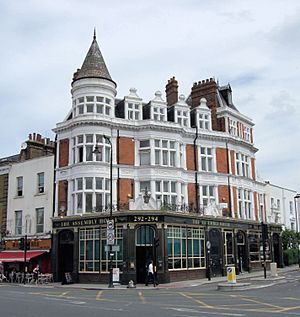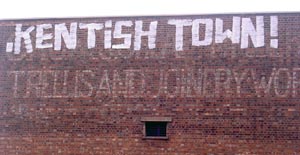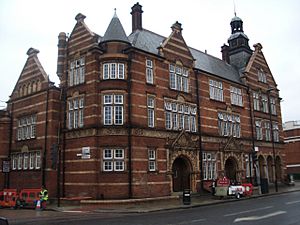Kentish Town facts for kids
Quick facts for kids Kentish Town |
|
|---|---|
 The Assembly House Pub, Kentish Town |
|
| OS grid reference | TQ285845 |
| London borough | |
| Ceremonial county | Greater London |
| Region | |
| Country | England |
| Sovereign state | United Kingdom |
| Post town | LONDON |
| Postcode district | NW5, NW1 |
| Dialling code | 020 |
| Police | Metropolitan |
| Fire | London |
| Ambulance | London |
| EU Parliament | London |
| UK Parliament |
|
| London Assembly |
|
Kentish Town is an area of northwest London, England in the London Borough of Camden, immediately north of Camden Town. Less than four miles north of central London, Kentish Town has good transport connections and is situated close to the open spaces of Hampstead Heath.
Kentish Town likely derives its name from Ken-ditch or Caen-ditch, meaning the "bed of a waterway." The area was initially a small settlement on the River Fleet, first recorded in 1207 during King John's reign. The early 19th century brought modernization to the area, and it became a popular resort due to its accessibility from London. Notably, Karl Marx resided at 46 Grafton Terrace in Kentish Town from 1856.
The area saw further development after World War II and has a rich history of political representation, with the Holborn and St Pancras seat held by Labour Party Prime Minister Keir Starmer as of April 2024. Kentish Town has also been a popular filming location for various movies and television shows. It is home to numerous independently owned shops, music venues, and cultural establishments, such as the Kentish Town Community Centre.
Contents
Toponymy
The name of Kentish Town is probably derived from Ken-ditch or Caen-ditch, meaning the "bed of a waterway" and is otherwise unrelated to the English county of Kent. In researching the meaning of Ken-ditch, it has also been noted that ken is the Celtic word for both "green" and "river", while ditch refers to the River Fleet, now a subterranean river. However, another theory is the name comes from its position near the Fleet; it has been suggested that Kentish Town, which lies in between two forks of the Fleet, takes its name from cant or cantle (from the Middle English meaning "corner").
History
Kentish Town was originally a small settlement on the River Fleet (the waterway is now one of London's underground rivers). It is first recorded during the reign of King John (1207) as kentisston. By 1456 Kentish Town was a thriving hamlet. In this period a chapel of ease was built for its inhabitants.
The early 19th century brought modernisation, causing much of the area's rural qualities, the River Fleet and the 18th-century buildings to vanish, although pockets still remain, for example Little Green Street. Between the availability of public transport to it from London, and its urbanisation, it was a popular resort.

Large amounts of land were purchased to build the railway, which can still be seen today. Kentish Town was a prime site for development as the Kentish Town Road was a major route from London northwards. Karl Marx was a famous resident, living at 46 Grafton Terrace from 1856.
1877 saw the beginning of mission work in the area as it was then poor. The mission first held their services outside but as their funding increased they built a mission house, chapel, and vicarage. One mission house of the area was Lyndhurst Hall which remained in use before being taken over by the Council. The Council wished it to sell it for residential use, and the hall was demolished in 2006.
During the 19th century and early 20th century the area of Kentish Town became the home of several piano and organ manufacturers, and was described by The Piano Journal in 1901 as "...that healthful suburb dear to the heart of the piano maker".
A network of streets in the East of Kentish Town has streets named after places or persons connected with Christ Church, Oxford viz: Oseney, Busby, Gaisford, Caversham, Islip, Wolsey, Frideswide, Peckwater & Hammond. All these streets lay behind the Oxford Arms. Some of the freehold of these streets is still in the name of Christ Church Oxford.
A network of streets in the north of Kentish Town was formerly part of a large estate owned by St John's College, Cambridge. Lady Margaret Road is named after Lady Margaret Beaufort, foundress of St John's College. Burghley Road is named after Lord Burghley, Chancellor to Elizabeth I and benefactor of St John's. Similarly, College Lane, Evangelist Road and Lady Somerset Road are street names linked to the estate of St John's College.
In 1912 the Church of St. Silas the Martyr (designed by architect Earnest Charles Shearman) was finally erected and consecrated, and by December of that year it became a parish in its own right. It can still be seen today along with the church of St Luke with St Paul and the Church of St. Barnabas (handed over to the Greek Orthodox Church in 1957). The present Church of England parish church is St. Benet's.
In his poem Parliament Hill Fields, Sir John Betjeman refers to "the curious Anglo-Norman parish church of Kentish Town".
Kentish Town Road contains one of London's many disused Tube stations. South Kentish Town tube station was closed in June 1924 after strike action at the Lots Road power station meant the lift could not be used. It never reopened as a station, although it was used as an air raid shelter during World War II. The distinctive building is now occupied underground by a massage shop and on ground level by a 'Cash Converters' pawn shop at the corner of Kentish Town Road and Castle Road. There have been proposals to rebuild the station.
Kentish Town was to see further modernisation in the post-World War II period. However, the residential parts of Kentish Town, dating back to the mid-19th century have survived.
Demography
In the 2011 census, 53% of the population was White British and 15% were White Other.
Filming location
In 2002 the comedy and drama film About a Boy was filmed in Lady Margaret Road, which is located at the top of Kentish Town, and Oseney Crescent. Many of the filming locations used in the 2006 film Venus, starring Peter O'Toole, Leslie Phillips, and Jodie Whittaker were in Kentish Town. In 1959 Lady Somerset Road and Oakford Road were used substantially for the filming of Sapphire, a film exploring racial tension in London, directed by Basil Dearden. The Assembly House pub was the location for the 1971 film Villain starring Richard Burton. The 1993 comedy Bad Behaviour, featuring Stephen Rea and Sinéad Cusack, was set in Kentish Town and includes scenes set in several local streets and the Owl Bookshop.
The 1947 Ealing Studios film It Always Rains on Sunday had scenes shot in Clarence Way during 1944 or 46 showing Holy Trinity Church with just the lower part of its spire still intact following the destruction of the upper section of the spire in WWII. The entire spire has since been removed leaving the church, effectively, with a tower. ..... In addition, the video of the Madness track "Baggy Trousers" was filmed at Islip Street School and the park in Kentish Town.
The Anglican Parish Church of St John Kentish Town, now known as "Christs Apostolic Church", was used by Only Fools and Horses as the backdrop (in external scenes) exterior of the Church where Damien was christened.
Plenty of exterior shots in the BBC tragicomedy Fleabag were filmed in Kentish Town, star/writer Phoebe Waller-Bridge being a resident.
Shops and businesses
In 2005, a survey of Kentish Town by the local Green Party claimed that out of 87 shops on Kentish Town Road (locally known as Kentish Town High Street), 53 were still independently owned. The high street is a mixture of national retail chains and independent shops, including a long-standing bookshop, several delis and organic stores. Many 'World Food' shops have opened up on the street. However, since 2009 there has been a marked increase in independent shops being replaced with chain stores including Pret a Manger, Costa Coffee, Caffe Nero and Sainsbury's.
Kentish Town Community Centre
Kentish Town Community Centre is a community centre, created in 2004, to provide meeting spaces and activities for local residents of all ages.
Culture
Pub rock is usually traced back to the "Tally Ho" in Kentish Town, a former jazz pub, where Eggs over Easy started playing in May 1971, and were soon joined by Bees Make Honey, Brinsley Schwarz, Max Merritt and the Meteors, Ducks Deluxe and others. The Assembly House is a Grade II listed pub at 292–294 Kentish Town Road.
Kentish Town is also home to The Forum (formerly known as the Town and Country club), during the 1950s a cinema, and now a live music venue. Spring 2014 saw Kentish Town to get its first speak easy, 1920s style hidden bar, when Knowhere Special opened its doors next to Kentish Town station.
Torriano Avenue, dating back to 1848, is a Kentish Town street home to Pete Stanley, one of the country's best-known bluegrass banjo players; British actor Bill Nighy; and The Torriano Poets, where local poets have met for over 20 years and still hold weekly public poetry readings on Sunday evenings: its founder was John Rety. The street is also home to two pubs, one being an 1850s hostelry The Leighton, the other The Torriano, which was for many years an old-fashioned community off-licence. They take their names from the local landowners, Sir David Leighton and Joshua Torriano, who developed the land for housing in the mid 19th century.
.....
Kentish Town Sports Centre
The largest municipal building is the Kentish Town Sports Centre which opened as the St Pancras public baths in 1903, designed by Thomas W. Aldwinckle. The large complex originally had separate first and second class men's baths and a women's baths, along with a public hall. Little of the interior remains intact. The baths were closed in January 2007 for refurbishment and re-opened at the end of July 2010.
Architecture and geography
Kentish Town has a fairly large boundary, stretching from Camden Gardens to as a far north as the Highgate Road/Gordon House Road junction near Dartmouth Park. Kentish Town generally includes the areas to the west, around Queens Crescent and to the east around Torriano.
Notable residents
- John William Salter, Victorian geologist and palaeontologist
- Akala, rapper
- Ben Aaronovitch, writer
- Charles Dance, actor
- Kingsley Ben-Adir, actor
- Tobias Menzies, actor
- Gerry Badger, photographer
- Mike Barson, keyboardist of the British pop/ska band Madness
- Siân Berry, Green Party politician and 2008 Green Party candidate for London Mayor
- Archie Bland, journalist, writer and Deputy Editor of The Independent newspaper
- Phil Clifton, TV and radio presenter
- Tom Conti, actor
- Giles Coren, restaurant critic
- Joe Craig, author of the Jimmy Coates series
- Hunter Davies, writer
- Simon Day, comedian
- Noel Fielding, comedian
- William Harrison, popular tenor and actor
- Mr Hudson, singer
- Margaret Forster, writer
- Ben Goldacre, medical doctor and journalist
- Eddy Grant, reggae and rock artist
- Patricia Hewitt, former Secretary of State for Health
- Tom Hiddleston, actor
- Leigh Hunt, 19th century journalist and poet
- Bert Jansch, folk musician
- Daniel Kaluuya, actor
- Roger Lloyd-Pack, actor
- Katharine Sarah Macquoid, writer
- Karl Marx, 19th century political philosopher
- Scott Mills, radio DJ
- Peter Robert Henry Mond, – (28 February 1948– 28 August 2018) former Lord in Waiting, Parliamentary Under-Secretary of State and Minister of State
- Harry Mount, historian, barrister and journalist
- Mae Muller, singer and songwriter
- Henry Neele, poet
- Mohamed Nur, Mayor of Mogadishu
- George Orwell, writer
- Gareth Peirce, solicitor
- Lucy Porter, comedian
- Daniel Prenn (1904–1991), Russian-born German, Polish, and British world-top-10 tennis player
- James Canham Read (1855–1894) the "Southend Murderer"
- Jolyon Rubinstein, comedian
- Alan Rusbridger, editor of The Guardian newspaper
- Jon Snow, television journalist
- Keir Starmer, former Director of Public Prosecutions, since 2024 Prime Minister of the United Kingdom
- Jim Sturgess, actor and musician
- The Roots, band
- R. N. Taber, poet
- Gillian Tindall, writer and historian
- Roz Walker
- Astrid Zydower, sculptor
- Katherine Pierce, actress
- Phoebe Waller-Bridge, writer/actress
- Tim Key, comedian and poet
Transport
Kentish Town has a range of transport connections: a mainline railway station that is served by Thameslink along with an interchange to the London Underground; Underground stations, overground connection (at Kentish Town West and Camden Road stations) and multiple bus routes with the majority going into or around Central London.
Bus Routes
The following Bus Routes serve Kentish Town: 88 (24 hour), 134 (24 hour), 214 (24 hour), 393 and Night Bus Route N20.
Nearest stations
- Kentish Town station
- Gospel Oak railway station
- Kentish Town West railway station
- Camden Road railway station
- Camden Town tube station
- Caledonian Road tube station
Neighbouring areas
- Camden Town and Chalk Farm to the south
- Barnsbury to the south-east
- Tufnell Park and Holloway to the east
- Dartmouth Park and Archway to the north-east
- Highgate to the north
- Hampstead and Belsize Park to the west




